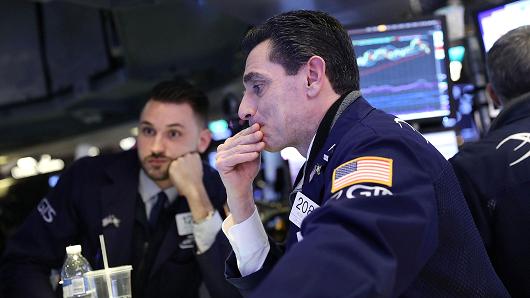
Political risk has replaced rising interest rates as the bigger fear in the stock market for now, and concerns about trade wars or other White House drama will be the market focus in the week ahead.
The stock market had its worst week since January 2016, in a violent sell-off that sent the Dow into a full-blown correction, 11.6 percent from its January highs. The Dow fell 5.7 percent for the week, to 23,533, and is on track for its worst quarter since the third quarter 2015, with a 4.8 percent decline so far.
Stocks sold off hard into the close Friday, with the S&P 500 plummeting 2.1 percent to 2,588, just above its low of the day at 2,585 — also the 200-day moving average.
“This is basically a weekend where the geopolitical risk is very high, and I think people were very reluctant to take exposure home over the weekend. Having seen the most recent flow data, it’s hard to make the case that the public is a buyer here as well,” said Julian Emanuel, chief equity and derivatives strategist at BTIG.
“It’s a cumulative air of uncertainty with the escalation of trade tensions and the personnel turnover [at the White House], along with the signal that lower yields, higher oil prices are sending investors,” Emanuel said.
When stocks corrected in February, the catalyst was a quick jump in interest rates and the fear inflation would prompt the Fed to speed up its rate hikes. Now, as the market looks set to retest those February lows, investors are more fearful about what might come out of the White House.
In the past week, President Donald Trump’s lead lawyer on the Russia investigation resigned, and H.R. McMaster was replaced as national security advisor by former U.N. Ambassador John Bolton.
Analysts said the hardline Bolton could look for a more aggressive stance against some U.S. adversaries, such as Iran. Analysts say Bolton could push the administration to drop out of the Iran nuclear deal when it is up for renewal in May, and that in turn could drive oil prices higher.
“It’s a pretty big wild card. The S&P 500 hit the 200-day right as the market closed, and it didn’t have time to react there. You could either have a Black Monday-type day or not,” said Scott Redler, partner with T3Live.com.
The 200-day is widely watched, and it could be a support level, as it was in the February sell-off. But Redler points out that the Feb. 9 low was a lot easier for traders to play since the S&P hit it during the trading day, when it bounced off it and closed higher. This time it’s unclear whether there will be a bounce since the market closed right on that level, and traders won’t know if the retest worked until Monday.
“This could be the type of weekend where sentiment gets even more negative and you get more rhetoric out of Washington that could trigger a harsher response from China that the markets might not like,” Redler said.
The market is extremely worried about the potential for trade wars that could slow global growth and pinch corporate profits. Trump announced tariffs on $50 billion in Chinese goods Thursday, and investors reacted by selling stocks that could be hurt in a trade war, including industrial and tech names. Technology was also at the heart of the week’s sell-off, losing 7.9 percent because of concerns about new regulation after the Facebook data scandal.
“We think there’s further underperformance likely in the tech sector, but does that mean the market has to go careening through its lows? Not necessarily,” said Emanuel. “The next week is potentially a quiet week, a holiday week; you could see, albeit potentially short term, you could see at least a little firming in the market.”
Patrick Kernan, principle with Cardinal Capital, said he expects lots of volatility in the holiday-shortened four-day week. He trades S&P 500 options and said there was a lot of activity Friday but no panic in the market, as there was in February.
“I am really concerned that nobody wants to step in right now. I think the moves are going to be much more violent next week, whether they be up or down, as a lack of liquidity in the market increases as we go into the end of the month,” said Kernan.
Kernan and many in the markets have been watching the ticking up of Libor [London interbank offered rate] over the past several weeks, and he expects that move up in short-term bank funding costs will continue. Traders look at the premium of Libor above the overnight index swap, and it has risen to 58, a new 9-year high, according to Reuters.
Traders are concerned because the spread tends to rise when there is stress in the market, but now it’s being blamed on a large issuance of Treasury bills and the repatriation of overseas cash by corporations, in response to the new tax law.
Michael Schumacher, director of rate strategy at Wells Fargo, said Treasury yields could rise at the short end in the coming week unless the headlines around trade disputes get more negative. Short end rates are most affected by Fed rate hikes.
“I think it’s really being driven by the trade thing. If that gets any uglier, you’ll see a risk-off move and that will mean a bid for bonds,” he said.
There is a busy economic calendar in the week ahead, including S&P/Case-Shiller home prices Tuesday, and personal income and spending Thursday. That includes the closely watched PCE deflator inflation data, watched by the Fed.

